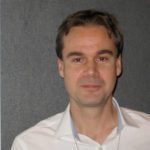Lien vers Pubmed [PMID] – 27148882
PLoS Genet. 2016 May;12(5):e1006015
Haploid germline nuclei of many filamentous fungi have the capacity to detect homologous nucleotide sequences present on the same or different chromosomes. Once recognized, such sequences can undergo cytosine methylation or cytosine-to-thymine mutation specifically over the extent of shared homology. In Neurospora crassa this process is known as Repeat-Induced Point mutation (RIP). Previously, we showed that RIP did not require MEI-3, the only RecA homolog in Neurospora, and that it could detect homologous trinucleotides interspersed with a matching periodicity of 11 or 12 base-pairs along participating chromosomal segments. This pattern was consistent with a mechanism of homology recognition that involved direct interactions between co-aligned double-stranded (ds) DNA molecules, where sequence-specific dsDNA/dsDNA contacts could be established using no more than one triplet per turn. In the present study we have further explored the DNA sequence requirements for RIP. In our previous work, interspersed homologies were always examined in the context of a relatively long adjoining region of perfect homology. Using a new repeat system lacking this strong interaction, we now show that interspersed homologies with overall sequence identity of only 36% can be efficiently detected by RIP in the absence of any perfect homology. Furthermore, in this new system, where the total amount of homology is near the critical threshold required for RIP, the nucleotide composition of participating DNA molecules is identified as an important factor. Our results specifically pinpoint the triplet 5′-GAC-3′ as a particularly efficient unit of homology recognition. Finally, we present experimental evidence that the process of homology sensing can be uncoupled from the downstream mutation. Taken together, our results advance the notion that sequence information can be compared directly between double-stranded DNA molecules during RIP and, potentially, in other processes where homologous pairing of intact DNA molecules is observed.

